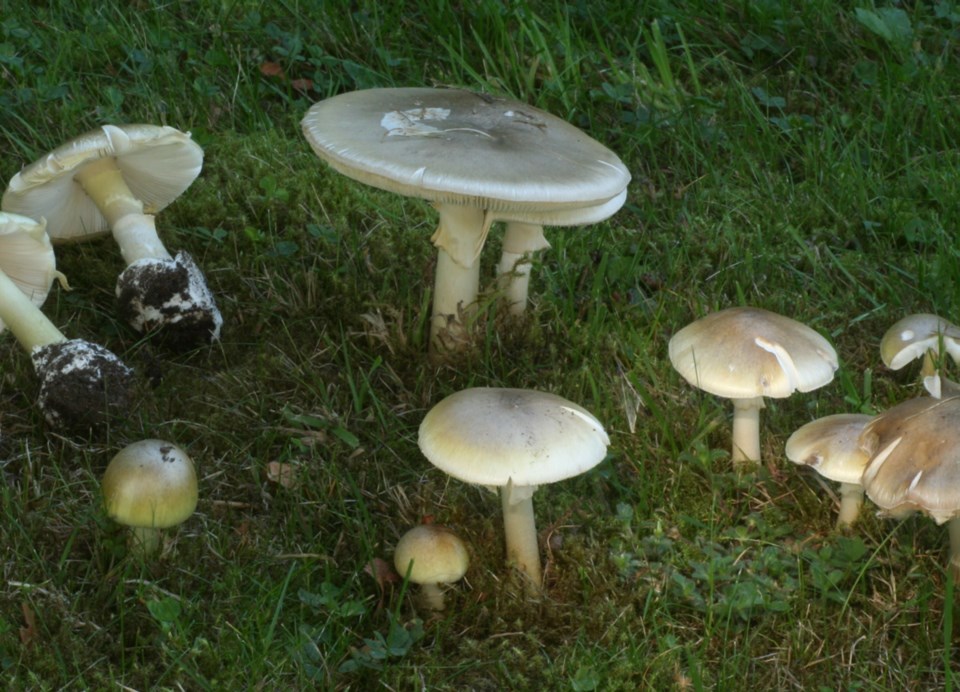The highly toxic “death cap” mushroom, responsible for the death of a Victoria toddler in 2016, has already been found growing in Greater Victoria, much earlier than expected, Island Health warns.
Amanita phalloides mushrooms can be found in both urban and rural areas under ornamental European hardwoods introduced here about 50 years ago and more recently under native oak trees.
The death caps usually mature under fall rains but with abundant summer watering of lawns and boulevards, they are sprouting early, said Island Health’s Dr. Richard Stanwick, chief medical health officer.
New this year, the mushrooms have been found fruiting near Kings Pond on the Cedar Hill Golf Course and in the Uplands area near the Royal Victoria Yacht Club, said B.C. Environment Ministry research scientist Shannon Birch.
“There’s no location you won’t find [them] over time if you go looking,” Stanwick said.
“To assume it’s not in your neighbourhood could be a very serious mistake.”
Island Health is warning the mushrooms can make you sick or kill you if ingested.
Up to 30 per cent of people who eat a death cap will die. Vomiting begins about eight to 12 hours after ingestion; after about 72 hours, without medical intervention, the toxins can attack the liver and kidney and cause organ failure.
“The issue is unintentional ingestion,” Stanwick said.
While rare, the concern is that toddlers and pets will mistakenly put them in their mouths or that amateur mushroom pickers will inadvertently harvest them for consumption.
The visible differences between death caps and non-poisonous mushrooms can be “subtle and even microscopic in some cases,” Stanwick said.
Worse, the mushroom is similar to many innocuous mushrooms such as the straw or paddy straw mushroom, a common part of the diet throughout east and southeast Asia, said Stanwick.
That contributed to the death of a Victoria toddler who died in an Edmonton hospital on Oct. 11, 2016, said Stanwick. The child was flown there by air ambulance after he was inadvertently served death caps a few days earlier.
“It was a tragic case of mistaken identification,” Stanwick said. The mushrooms were harvested from a site about a block from the Health Ministry building at Pandora and Blanshard streets. When health officials checked the area, as many as 25 of the death cap mushrooms were there, enough to kill a dozen adults, said Stanwick.
“Picking wild mushrooms should be left to people with significant expertise,” Stanwick said.
That death “was and still is the only death linked to death cap mushrooms on Vancouver Island,” said Island Health spokeswoman Meribeth Burton.
Andy MacKinnon, president of the South Vancouver Island Mycological Society, said members thought originally that signs could be erected where the mushrooms are fruiting, but once they spread to areas where native Garry oak grow, they realized the death caps could show up anywhere — “that’s what concerns us.”
The highlighting of the death cap mushroom is not meant to scare people but to warn them to be vigilant, said Stanwick.
Death cap mushrooms have shiny yellow, greenish or white caps, white gills underneath, and a white ring on the top of the stem.
Vancouver veterinarian Rob Ashburner, a member of the Society of B.C. Veterinarians, said he hasn’t had any pets suspected of eating the mushrooms this year.
When it happens, it’s mostly dogs and it’s sporadic from year go year, he said.
In the last case he recalls of a dog ingesting what was confirmed to be a death cap mushroom, Ashburner induced vomiting and started treatment to stop the organs from absorbing the deadly toxins. By the time the toxins get in the blood stream “it’s game over,” said Ashburner.
Warnings are being posted in some areas where the mushroom is known to be popping up, said Stanwick.
The invasive species was first reported in the province in 1997, and were spotted in Victoria the next year.
Island Health advises if you see death cap mushrooms, wear rubber gloves when removing them, wash your hands thoroughly, package them up with your regular garbage — do not compost or use the food recycling bin — and remember to remove them before mowing the lawn to avoid spreading them.



